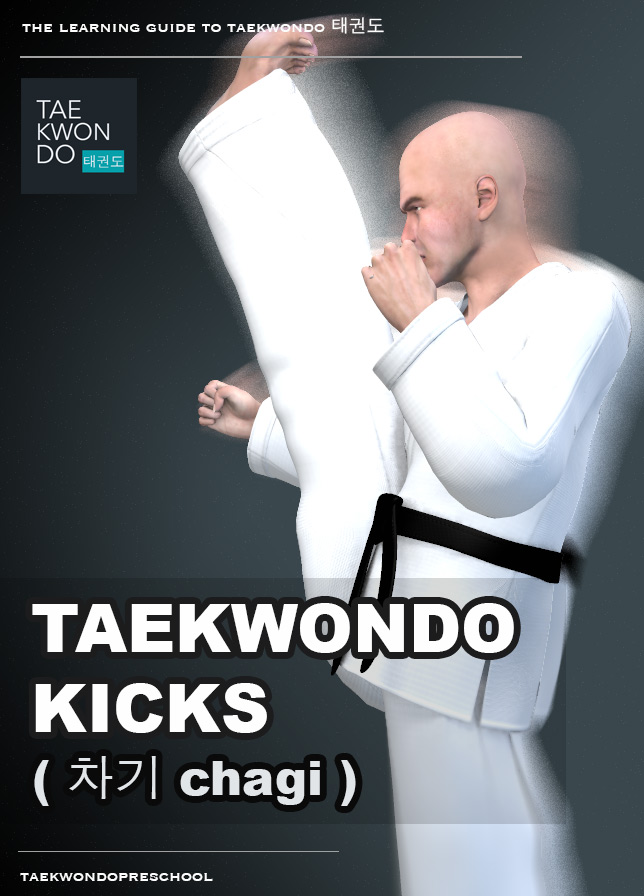Taekwondo 태권도Taekwondo Preschool
Promotion from one geup to the next can proceed rapidly in some schools, since schools often allow geup promotions every two, three, or four months. Students of geup rank learn the most basic techniques first, and then move on to more advanced techniques as they approach first dan. Many of the older and more traditional schools often take longer to allow students to test for higher ranks than newer, more contemporary schools, as they may not have the required testing intervals. View Taekwondo belt levels »
Skipping Axe Kick
발붙여 내려차기 balbucheo-naeryeo-chagi
A kick (차기 chagi) is a physical strike using the foot, leg, or knee. The striker relaxes to the extent possible during the strike, tensing the muscles of much of the body only at the time of impact, then relaxing again to recoil the striking part. Relaxation enables the strike to achieve the greatest possible velocity during travel, while rigidity at impact allows the maximum transfer of force.
Difficulty Level: Intermediate Technique: Kick ( 차기 chagi )
The Skipping Axe Kick ( 발붙여 내려차기 balbucheo-naeryeo-chagi ) is done by skipping or shuffling forward with the rear leg, moving the kicker closer towards the opponent while simultaneously chambering and unleashing the front leg to kick ( 차기 chagi ) with the Axe Kick ( 내려차기 naeryeo-chagi ). This method is linear and direct, striking the opponent with powerful forward momentum while covering some distance quickly.
The Axe Kick ( 내려차기 naeryeo-chagi ) begins with front leg foot ( 발 bal ) rising as high straight upwards, arc motion is stopped at the peak, and then the attacking foot ( 발 bal ) is lowered with extreme violent downward force so as to strike the target from above.
Use of the kick ( 차기 chagi ) is common during taekwondo sparring ( 겨루기 gyeorugi ) competition and self-defense ( 호신술 hosinsool ) applications. Practitioners can perform the kick ( 차기 chagi ) to strike the chest protector ( 호구 hogu ) or the face ( 얼굴 eolgul ) of the opponent. The chest protector ( 호구 hogu ) is the most common scoring area in taekwondo sparring ( 겨루기 gyeorugi ). The blue or red colored area of the body protector is the scoring targets.
Variations of Skipping Kick ( 발붙여차기 balbucheo-chagi )
- Skipping Front Kick ( 발붙여 앞차기 balbucheo-ap-chagi )
- Skipping Side Kick ( 발붙여 옆차기 balbucheo-yeop-chagi )
- Skipping Roundhouse Kick ( 발붙여 돌려차기 balbucheo-dollyeo-chagi )
- Skipping Axe Kick ( 발붙여 내려차기 balbucheo-naeryeo-chagi )
- Skipping Whip Kick ( 발붙여 후려차기 balbucheo-huryeo-chagi )
Training Methods
How well one improves with training depends on several factors, such as the frequency it is engaged in, and the type of feedback that is available for improvement. If a student does not train often enough, reinforcement fades, and he or she is likely to forget what was learned.
During training, taekwondo practitioners may use various equipment and gear for practicing the kick ( 차기 chagi ). Taekwondo extensively uses the heavy bag for developing power and endurance. Powerful strikes to the heavy bag aren't recommended for inexperienced, or younger athletes, as risk of sprain, strain, or bone plate damage may adversely affect bone structures. It is highly recommended to carefully focus strikes to reduce chance of injury.
The kick ( 차기 chagi ) is best learned initially striking at the air as though there is an opponent but focusing on the form, speed, control, and technique; then moving on to soft surfaces striking punch mitts and target pads. Large heavy bags are used more for strength and endurance, while smaller targets such as punch mitts and target pads focus on faster kicking speed, timing and coordination. Target pads are useful for training mobility and accuracy on a moving target.
In preparation for full contact sparring, students may be required to wait a few months, for safety reasons, because they must first build the skills they would ideally employ in their sparring practice. Some schools restrict the amount of force that may be used to hit an opponent, by allowing 'light contact' during sparring. Light contact allows a student to hit an opponent getting the feel of impacting the opponent but with controlled force and not full power. Light contact sparring is a good method to practice the technique.
Difficulty of Technique
Taekwondo students of geup ranking learn the most basic techniques first, and then move on to more advanced and difficult techniques as they approach 1st Dan Black Belt. The more difficult the technique, the more practice may be needed for the purpose of improving or mastering it, as in the phrase 'practice makes perfect'. Every technique must display the requisite speed, balance, power and firmness to be realistically used as an attack or defense move.
* Please see a certified Master Instructor ( 사범님 sabeomnim ) for training. Proper guidance and instructions are needed to ensure safe training.
Promotion Tests
Students often undergo periodic testing and grading by their own Master Instructor ( 사범님 sabeomnim ) in order to advance to a higher level of recognized achievement such as a different belt color. They need to demonstrate their proficiency in the various aspects of the art such as the execution of patterns ( 품새 poomse ), which combine various techniques in specific sequences.
Skipping Axe Kick ( 발붙여 내려차기 balbucheo-naeryeo-chagi ) is a requirement for the below belt levels (Techniques vary between schools). Promotion from one belt level to the next can proceed rapidly in some schools, since schools often allow geup promotions every two, three, or four months. Students of geup rank learn the most basic techniques first, and then move on to more advanced techniques as they approach first dan black belt. View Promotion Tests »

Training Safety Precautions
Meditation is a practice in which an individual trains the mind or induces a mode of consciousness. The practice has a calming effect and directs awareness inward until pure awareness is achieved, described as being awake inside without being aware of anything except awareness itself. Meditation is often used to clear the mind and ease many health issues, such as high blood pressure, depression, and anxiety.
In taekwondo, sometimes after the class finishes, the master ( 사범님 sabeomnim ) instructs the students to meditate in the dojang in a sitting cross-legged posture. Cooling down, also called warming down, is an easy exercise that will allow the body to gradually transition from an exertional state to a resting or near-resting state. View Meditation »
* Please see a certified Master Instructor ( 사범님 sabeomnim ) for training. Proper guidance and instructions are needed to ensure safe training.

Training Highlights Summary
The Kick ( 차기 chagi ) contains many key point highlights. There are some that are simple and straightforward but then some are complex and detailed that require repeated training to learn and master.
- skipping or shuffling forward with the rear leg, moving the kicker closer towards the opponent while simultaneously chambering and unleashing the front leg to kick with the Axe Kick ( 내려차기 naeryeo-chagi )
- the front leg kick is generally weaker than the rear leg kick because the hip does not rotate as much, however, it is also generally faster because the leg travels a shorter distance before striking the opponent
- upward arc motion is stopped at the peak, and then the attacking foot ( 발 bal ) is lowered with extreme violent downward force so as to strike the target from above
- characterized by a straightened leg descending onto an opponent like the blade of an axe or like the motion of a hammer on a nail
- when striking the target, the attacking leg could be straight down or bent in a whipping motion downward
- typically targeted toward the opponent's head ( 머리 meoli ), shoulder ( 어깨 eokkae ), or collarbone ( 쇄골 swaegol ) area, and requires significant flexibility to employ effectively
- the kicking surface could be the back of the heel ( 뒤꿈치 dwikkumchi ), bottom of the heel ( 뒤축 dwichuk ), or the sole area of the foot ( 발바닥 balbadak )
- remember to thoroughly do some warm-up and basic stretching activities before lifting your legs too high
- it can increase muscle control, flexibility and range of motion as a stretch kick
Strength Requirement of the Technique
Most strikes should generally be thrown with some measure of shifting body weight supporting the blow. The striker in combat should attempt to strike through the target area, not just contact the surface. Some strikes do not need as much strength as they target vulnerable areas such as the eyes ( 눈 nun ), neck ( 목 mok ) or sternum ( 흉골 hyung-gol ). The below is an approximate measurement of how much strength the strike requires from the practitioner to be effective.
Precision of Kicking ( 차기 chagi ) Technique
With proper execution opponents may be stopped with a single striking blow, which lessens the number of further strikes. Some kicks ( 차기 chagi ) can strike with more precision which will often cripple or knockout the opponent. The below is an approximate measurement of how precise the kick ( 차기 chagi ) requires from the practitioner to be effective.
Experienced practitioners learn through repetition and muscle memory when (not just how) to launch particular kicks ( 차기 chagi ), based on the circumstances they are facing.
* Please see a certified Master Instructor ( 사범님 sabeomnim ) for training. Proper guidance and instructions are needed to ensure safe training.
Risk of injury can be reduced by completing an effective warm up consisting of a heart raiser to get your pulse up, followed by sport specific dynamic stretches (stretches whilst moving). Please follow the guidance of a certified Master Instructor or trainer when doing sports related activities. Depending on the intensity of the exercise, cooling down can involve a slow jog or walk, or with lower intensities, stretching can be used. Cooling down allows the heart rate to return to its resting rate. View more information on Warming Up and Cooling Down ».
This article uses material from the Wikipedia articles "Warming Up" and "Cooling Down", which is released under the Creative Commons Attribution-Share-Alike License 3.0.
RESOURCES
This article uses material from the Wikipedia article "Kick" which is released under the Creative Commons Attribution-Share-Alike License 3.0.










































